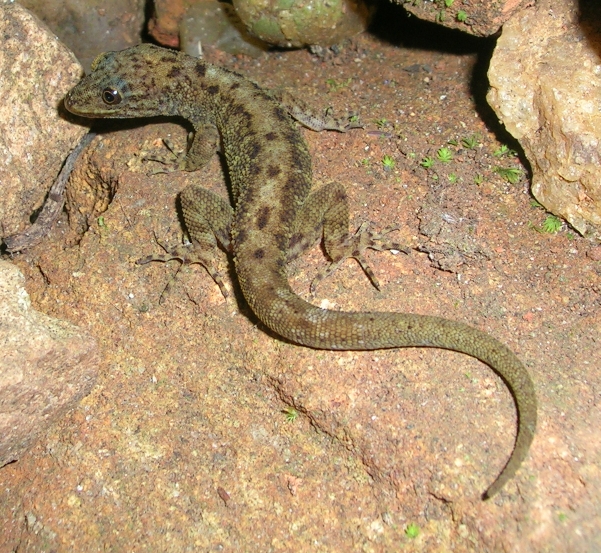|
Cnemaspis Selenolagus
''Cnemaspis selenolagus'' is a species of diurnal gecko Geckos are small, mostly carnivorous lizards that have a wide distribution, found on every continent except Antarctica. Belonging to the infraorder Gekkota, geckos are found in warm climates throughout the world. They range from . Geckos ar ... endemic to Thailand, specifically, the Thai-Malay Peninsula. It is noted for its sharp color change from yellow-orange to brown-gray. It allows them to blend into the lichens and dry moss that cover the surfaces of the rocks and evergreen tropical trees of the region. This is a common survival feature among other ''Cnemaspis'' species. During the day, ''Cnemaspis selenolagus'' spends its time on tree bark or rocks. At night, it takes shelter under tree bark and in the cracks of large boulders. Additionally, it gravitates towards areas which include rocky streams. It is presumed to be a habitat generalist. It is the sixteenth ''Cnemaspis'' species in Thailand. Eleven of th ... [...More Info...] [...Related Items...] OR: [Wikipedia] [Google] [Baidu] |
Gecko
Geckos are small, mostly carnivorous lizards that have a wide distribution, found on every continent except Antarctica. Belonging to the infraorder Gekkota, geckos are found in warm climates throughout the world. They range from . Geckos are unique among lizards for their vocalisations, which differ from species to species. Most geckos in the family Gekkonidae use chirping or clicking sounds in their social interactions. Tokay geckos (''Gekko gecko'') are known for their loud mating calls, and some other species are capable of making hissing noises when alarmed or threatened. They are the most species-rich group of lizards, with about 1,500 different species worldwide. All geckos, except species in the family Eublepharidae lack eyelids; instead, the outer surface of the eyeball has a transparent membrane, the cornea. They have a fixed lens within each iris that enlarges in darkness to let in more light. Since they cannot blink, species without eyelids generally lick t ... [...More Info...] [...Related Items...] OR: [Wikipedia] [Google] [Baidu] |
Thailand
Thailand ( ), historically known as Siam () and officially the Kingdom of Thailand, is a country in Southeast Asia, located at the centre of the Indochinese Peninsula, spanning , with a population of almost 70 million. The country is bordered to the north by Myanmar and Laos, to the east by Laos and Cambodia, to the south by the Gulf of Thailand and Malaysia, and to the west by the Andaman Sea and the extremity of Myanmar. Thailand also shares maritime borders with Vietnam to the southeast, and Indonesia and India to the southwest. Bangkok is the nation's capital and largest city. Tai peoples migrated from southwestern China to mainland Southeast Asia from the 11th century. Indianised kingdoms such as the Mon, Khmer Empire and Malay states ruled the region, competing with Thai states such as the Kingdoms of Ngoenyang, Sukhothai, Lan Na and Ayutthaya, which also rivalled each other. European contact began in 1511 with a Portuguese diplomatic mission to Ayutthaya, w ... [...More Info...] [...Related Items...] OR: [Wikipedia] [Google] [Baidu] |
Reptiles Of Thailand
The following is a list of reptiles of Thailand. There are more than 400 species recorded. Order Crocodylia (crocodilians) Order Testudines (turtles) Order Squamata, Suborder Lacertilia (lizards) Order Squamata, Suborder Serpentes (snakes) Common species Reptile species commonly found in anthropogenically modified environments (i.e., near human settlements) include:http://www.ahr-journal.com/OA/pdfdow.aspx?Sid=210130105 *''Calotes versicolor'' (oriental garden lizard) *''Eutropis macularia'' (bronze grass skink) *'' Eutropis multifasciata'' (common sun skink) *''Gekko gecko'' (tokay gecko) *''Gehyra mutilata'' (stump-toed gecko) *''Hemidactylus frenatus'' (common house gecko) *'' Hemidactylus platyurus'' (flat-tailed house gecko) *''Ramphotyphlops braminus'' (common blind snake) *''Python reticulatus'' (reticulated python) *''Dendrelaphis pictus'' (painted bronzeback) *'' Enhydris plumbea'' (rice paddy snake) *''Ptyas mucosa'' (oriental ratsnake) *''Rhabdophis subminiatus' ... [...More Info...] [...Related Items...] OR: [Wikipedia] [Google] [Baidu] |
Reptiles Described In 2020
Reptiles, as most commonly defined are the animals in the class Reptilia ( ), a paraphyletic grouping comprising all sauropsids except birds. Living reptiles comprise turtles, crocodilians, squamates ( lizards and snakes) and rhynchocephalians (tuatara). As of March 2022, the Reptile Database includes about 11,700 species. In the traditional Linnaean classification system, birds are considered a separate class to reptiles. However, crocodilians are more closely related to birds than they are to other living reptiles, and so modern cladistic classification systems include birds within Reptilia, redefining the term as a clade. Other cladistic definitions abandon the term reptile altogether in favor of the clade Sauropsida, which refers to all amniotes more closely related to modern reptiles than to mammals. The study of the traditional reptile orders, historically combined with that of modern amphibians, is called herpetology. The earliest known proto-reptiles originated ... [...More Info...] [...Related Items...] OR: [Wikipedia] [Google] [Baidu] |
Cnemaspis
''Cnemaspis'' is a genus of diurnal (day) geckos found in Asia. With over 100 species, it is one of the most diverse genera of geckos. Molecular phylogenies suggest that the two regional groupings may form distinct clades which are not each other's closest relatives. Description Species in this genus have slender, clawed digits which are cylindrical or depressed at the base (rarely dilated); the distal phalanges are compressed, forming an angle with the basal portion of the digits, the lower surface of which has a row of plates. Their bodies are more or less depressed, granular or tubercular above. Tail not compressed. Pupil circular; eyelid distinct all round the eye. Males with or without pre-anal or femoral pores. Species The Indian Subcontinent and Sri Lanka group *'' C. aaronbaueri'' Sayyed, Grismer, Campbell & Dileepkumar, 2019 *'' C. adii'' C. Srinivasulu, Kumar & B. Srinivasulu, 2015 – Adi's day gecko *'' C. agarwali'' Khandekar, 2019 – Agarwal's dwarf gec ... [...More Info...] [...Related Items...] OR: [Wikipedia] [Google] [Baidu] |

